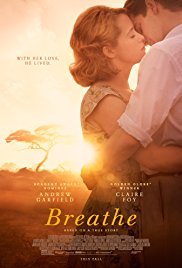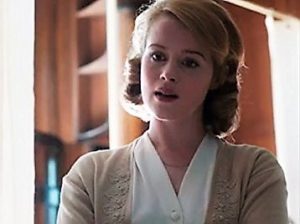Breathe ** (2017, Andrew Garfield, Claire Foy, Tom Hollander, Hugh Bonneville, Ed Speleers, Diana Rigg) – Movie Review
Actor Andy Serkis’s directorial debut is a surprisingly traditional and conventional biopic film. It is also straightforward, plain and sentimental, just when something rigorous and offbeat, even experimental, is required. It is very honorable, very English and very conservative.
Thanks to bis film roles, Serkis seems like an edgy, spiky sort of individual. But that can’t be right because his debut is such a smooth, retro kind of film, a very BBC Films kind of film. It is a thoroughly professional piece of work, brisk, smooth and efficient, but more is needed, especially from a film opening the London Film Festival.
Breathe celebrates a man’s kind of survival in the worst possible circumstances – struck down by the devastating disease of polio – and the victory of his bravery and his wife and friends’ true love over appalling misfortune. So it means terribly well. We can all identify with that and approve of it. Yes it is kind of heartwarming and inspiring but in a kind of intellectual way, not in a way that stirs the blood or raises the tears.
Andrew Garfield has a tough job acting with just his face as polio paralysed Robin Cavendish, but does it well enough, and Claire Foy is good as the brisk and capable, thoroughly determined wife Diana. We are celebrating old-style English virtues here, and that feels awkward, what with the posh, clipped accents and period lingo, and some kind of outmoded attitudes. Where’s the emotion, anger, rage, hurt and pain? I suppose it is all internal, somewhere hidden.
The shots (by cinematographer Robert Richardson) are very traditional, and the music – both score (by Nitin Sawhney) and soundtrack – a bit corny. A lot less music would create a much better, harder-edged film.
[Spoiler alert] Even in the film’s final stages when the wife is coping with her husband’s losses of blood, and his final decision to go for assisted death, the film won’t push hard into the danger zone. These scenes should scare and be terrifying. But, instead, they are merely just happening there quite sweetly and serenely on screen.
Diana Rigg may be top billed on the IMDb but she has three lines of dialogue as rich benefactor Lady Neville, who gives her money for polio victims’ chairs. Comedy relief Tom Hollander is pretty slack and feeble as twin friends, Hugh Bonneville is just quickly on and off as cheery inventor boffin Teddy Hall, while Ed [Edward] Speleers battles a weakly written role as another loyal friend, Colin Campbell.
Honestly, we just need to know more about these characters to care about them fully, a whole lot more. Actually, we need to know more about the two main characters too. We don’t really learn enough about what makes them tick, what makes them special, besides being in unshakeable love and being victims of a terrible fate.
Film producer Jonathan Cavendish is Robin’s real-life son, played by several different boys in the stages of the movie.
Parts of the film were shot at Royal Air Force Benson, in Hluhluwe, South Africa and at Hatfield House in Hertfordshire, England.
© Derek Winnert 2017 Movie Review
Check out more reviews on http://derekwinnert.com



